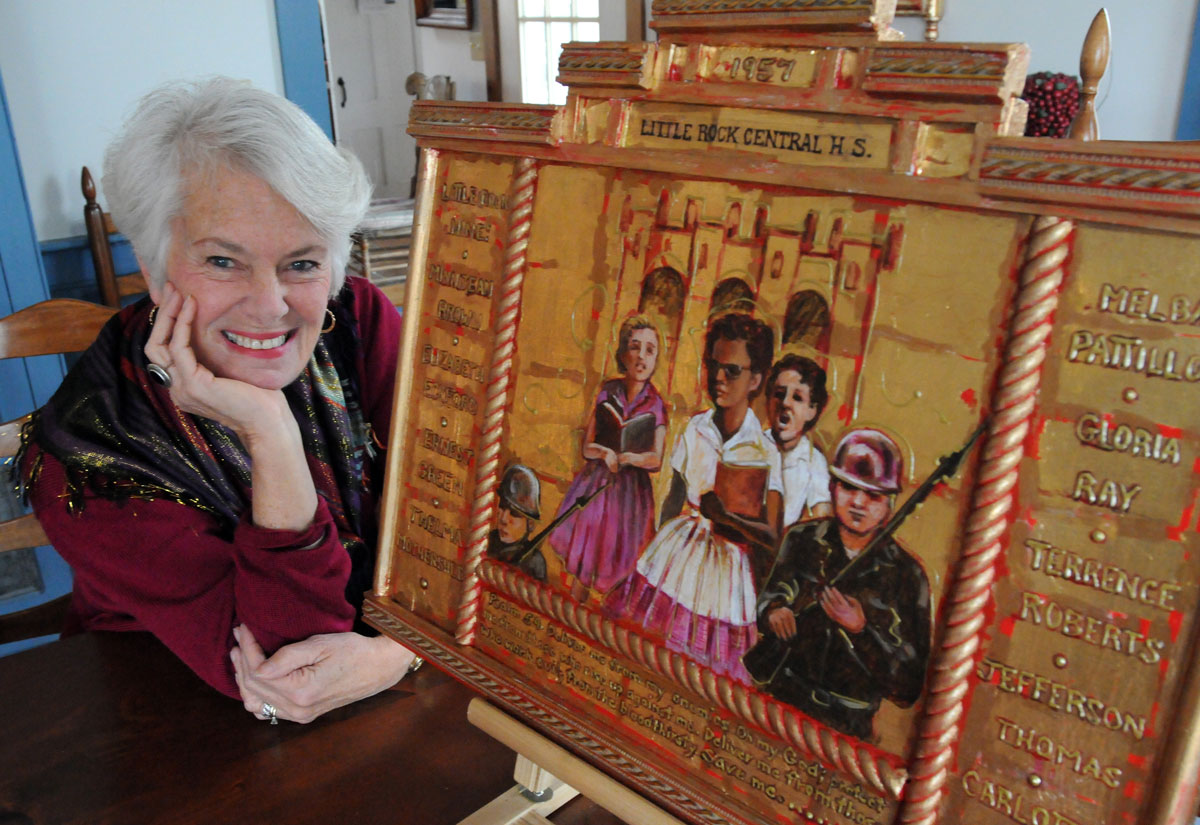
amela Chatterton-Purdy ’63 remembers clearly the first time she witnessed blatant racism. It was 1955. She was 15, living in Connecticut. Her father worked for Allied Van Lines. One day, he came home excited to share that he had received a call from Jackie Robinson, who, as first baseman for the Brooklyn Dodgers, had become the first Black major league baseball player. Number 42 wanted Allied Van Lines to move him to Stamford.
“That evening we received hate phone calls from the neighbors. ‘Mr. Chatterton, you better not move that [N-word] into our neighborhood.’ ‘Mr. Chatterton, do you care about the health of your four daughters?’ As a 15-year-old I was shocked. We were not living in the South but right here in Connecticut,” Chatterton-Purdy says.
That experience, and too many others like it — the 1963 March on Washington, the 16th Street Baptist Church bombing — provided the impetus for the direction Chatterton-Purdy’s art would take years later.
Chatterton-Purdy married David Purdy in June 1963, the month after she received her art degree from UNH. He had just graduated from the Yale Divinity School. In August, they moved to Chicago, where David Purdy joined the Ecumenical Institute and Chatterton-Purdy went to work at Ebony magazine as an art editor.
During the interview, she met with the company president. “I showed him my portfolio and he looked at me and said, ‘Well, I guess I can hire as many whites as Look Magazine hires Blacks.’ I was one of two white employees in a company of 150.”
One of Chatterton-Purdy’s colleagues was a woman named Carla. One Friday Carla asked Chatterton-Purdy if she would set up a showing for a house that was for sale in the Chicago suburbs. When she asked why Carla didn’t make the call herself, the woman said they would be able to tell by her voice that she was Black. So Chatterton-Purdy made the call for her.
“On Monday Carla came into my office. With a long face she said, ‘As soon as that woman saw that I was Black she said, ‘Oh, I am so sorry. This property went under agreement this morning,’” Chatterton-Purdy says. “My involvement in the civil rights movement started in part because of my job at Ebony magazine. The racism that my colleagues were experiencing was an eye-opener.”
In 1964, David Purdy was appointed a chaplain at the University of Massachusetts-Boston. Chatterton-Purdy enrolled at the school and received her master’s in fine art. The couple has four children, two biological daughters, an adopted son who is Black and another who is Black Vietnamese. Chatterton-Purdy wrote a book about the experience of being a racially integrated family. “Beyond the Babylift, A Story of an Adoption” was published in 1987.
In 2004, the Purdys went on a civil rights tour through the Deep South, where they met Georgia congressman John Lewis, Minnie Jean Brown of the Little Rock Nine and civil rights activist Fred Shuttlesworth, among others.
“We were blown away by these people. Black, white, Protestant, Catholic, all working non- violently for change. They marched, they prayed, they sat-in, despite shootings, lynchings, church bombings. All of this in the face of hate. Despite a world that was telling them they were of no worth,” Chatterton-Purdy recalls. “I came home and created 16 icons in three and a half months.” Those pieces formed the foundation of the now 46-piece collection, “Icons of the Civil Rights Movement.”
The images are done on wood in gold-leaf. Some are enhanced with lengths of chain and locks, upholstery braids, cloth flags. They depict such noted figures as Frederick Douglass, Emmett Till, Martin Luther King, The Little Rock Nine and Trayvon Martin. When Barack Obama was elected president, his became the 17th icon. Along with the other 16, it was exhibited in Washington, D.C., at his 2009 inauguration. The collection has been displayed at more than 40 colleges, including UNH, as well as in galleries and schools and the Massachusetts State House.
“There are so many people to be honored,” Chatterton-Purdy says. “I receive emails, calls, always saying ‘but you haven’t done so and so.’” When not traveling, Chatterton-Purdy’s icons are on exhibit at the Zion Union Heritage Museum in Hyannis, Massachusetts, an Afrocentric museum on Cape Cod. “We have met so many people who marched with Dr. King, were jailed as children in Birmingham in 1963 —. To say that this ‘movement’ influenced our lives over the past 57 years is an understatement.”